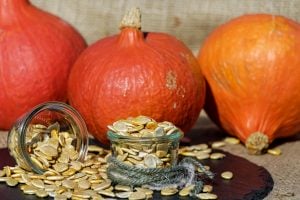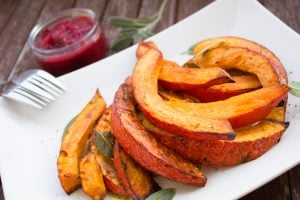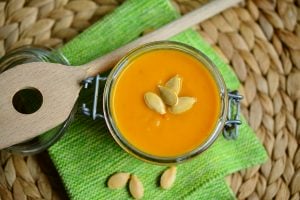 The Halloween time is approaching, and pumpkin is inextricably linked with this holiday. Pumpkin should serve us not only as an ornament, but also as a mandatory part of our diet. Pumpkin provides us with a very large amount of carotenes, and therefore precursors of vitamin A and strong antioxidants. Munching on pumpkin seeds is also an excellent snack providing us with lots of very healthy fatty acids. However, these are just some of the properties of the pumpkin. Read this article and find out how much health Halloween pumpkin can bring you!
The Halloween time is approaching, and pumpkin is inextricably linked with this holiday. Pumpkin should serve us not only as an ornament, but also as a mandatory part of our diet. Pumpkin provides us with a very large amount of carotenes, and therefore precursors of vitamin A and strong antioxidants. Munching on pumpkin seeds is also an excellent snack providing us with lots of very healthy fatty acids. However, these are just some of the properties of the pumpkin. Read this article and find out how much health Halloween pumpkin can bring you!
Today’s pumpkin has its roots in the regions of Guatemala and Mexico. This vegetable has been consumed for over 10,000 years. Initially, however, the pumpkin was grown only for obtaining seeds, because the pulp itself was too bitter in taste. With the passage of time, pumpkin cultivation spread throughout America and new sweeter varieties were created. Pumpkin came to Europe thanks to the expeditions of Christopher Columbus, when Portugal and Spain became the main places of cultivation of this vegetable. Today, the largest pumpkin suppliers are China, Japan, Romania, Turkey, Italy, Egypt and Argentina.
For many years, pumpkin has been regarded by dieticians as a valuable source of carotenoids. However, only recent scientific studies have shown that pumpkin is not only a good source, but one of the best! In many reports, pumpkin is amongst the first three main products that provide us with antioxidants such as α-carotene, β-carotene, lutein, zeaxanthin, β-cryptoxanthin. These studies come from all over the world, from the USA and South America through Africa to India and Asia. However, carotenoids are not the only antioxidants pumpkin is full of. A portion of pumpkin (about 200g) contains up to one third of the daily requirement for vitamin C! In addition, it is also an excellent source of manganese (20% of the average daily requirement).
 Pumpkin seeds are a great and healthy snack. For better taste pumpkin seeds can be roasted in the oven. All you have to do is sprinkle the seeds separated from the fresh pumpkin on the baking tray and put them in the oven for 15-20 minutes. Remember to set a low temperature (75oC), so that healthy fatty acids will not undergo chemical changes. It should be noted here that linoleic acid (polyunsaturated fatty acid from the omega-6 group) together with oleic acid (exactly the same fatty acid, which is mainly known for its presence in olive oil) constitutes up to 75% of fats contained in pumpkin seeds.
Pumpkin seeds are a great and healthy snack. For better taste pumpkin seeds can be roasted in the oven. All you have to do is sprinkle the seeds separated from the fresh pumpkin on the baking tray and put them in the oven for 15-20 minutes. Remember to set a low temperature (75oC), so that healthy fatty acids will not undergo chemical changes. It should be noted here that linoleic acid (polyunsaturated fatty acid from the omega-6 group) together with oleic acid (exactly the same fatty acid, which is mainly known for its presence in olive oil) constitutes up to 75% of fats contained in pumpkin seeds.
People on low-carbohydrate diets may be reluctant to eat pumpkin. However, that is unnecesary! It is true that this vegetable contains a large amount of starch, because 90% of pumpkin’s calories come from carbohydrates, and half of these carbohydrates are starchy-like. However, the researchers emphasise that the chemical form of pumpkin-derived starch is significantly different from starch in cereals or potatoes. Carbohydrates of this orange vegetable are found mainly in the cell walls and contain a unique large amount of a specific polysaccharide chain called homogalacturonate. Recent research shows that this compound has antioxidant and anti-inflammatory properties, and further supports the regulation of insulin production.
 We owe the anti-inflammatory properties of pumpkin to compounds called cucurbitacins. Cucurbitacins are molecules that can be found in cabbage vegetables, mushrooms and some seafood. This substance can be very bitter in taste, which is why it is considered a kind of defense system of plants against being eaten by animals. Many forms of cucurbitacins are also toxic to animals. On the other hand, the one found in pumpkin has antiviral, antibacterial and anti-inflammatory properties. We should also remember that omega-3 fatty acids also protect us against inflammation. One serving of pumpkin provides as much as 340 mg of α-linolenic acid. For comparison, the content of α-linolenic acid in pumpkin is one third of the amount provided by walnuts, the best source of this compound. It should be noted, however, that pumpkin is much less caloric than nuts. Only 15% of pumpkin’s calories come from fats, while in nuts it is 90%. This vegetable is therefore an excellent low-calorie product that provides us with a lot of health derived from fatty acids.
We owe the anti-inflammatory properties of pumpkin to compounds called cucurbitacins. Cucurbitacins are molecules that can be found in cabbage vegetables, mushrooms and some seafood. This substance can be very bitter in taste, which is why it is considered a kind of defense system of plants against being eaten by animals. Many forms of cucurbitacins are also toxic to animals. On the other hand, the one found in pumpkin has antiviral, antibacterial and anti-inflammatory properties. We should also remember that omega-3 fatty acids also protect us against inflammation. One serving of pumpkin provides as much as 340 mg of α-linolenic acid. For comparison, the content of α-linolenic acid in pumpkin is one third of the amount provided by walnuts, the best source of this compound. It should be noted, however, that pumpkin is much less caloric than nuts. Only 15% of pumpkin’s calories come from fats, while in nuts it is 90%. This vegetable is therefore an excellent low-calorie product that provides us with a lot of health derived from fatty acids.
The properties of pumpkin to improve the health of people with diabetes due to not only the previously discussed polysaccharide compounds, but also the high content of vitamins from the group B. Pumpkin has an unusual combination of vitamin B1, B3, B6, pantothenic and foil acids. These micronutrients have a large share in regulating glucose level in blood. However, the most important compound in the pumpkin for diabetics is d-chiro-inositol. It is a substance that plays a role in the release of insulin from the pancreas. Scientific research shows that d-chiro-inositol effectively increases insulin sensitivity and improves glucose metabolism in the body.
 Through a high dose of antioxidant and anti-inflammatory compounds, pumpkin has been of interest to cancer scientists. Up to now, the relationship with prostate cancer has been the most studied, followed by colon, breast and lung cancer. The research results look very promising, but most of them have been obtained thanks to the use of pumpkin extracts. So we have to wait for scientific research taking into account the natural portions of pumpkin that we eat every day.
Through a high dose of antioxidant and anti-inflammatory compounds, pumpkin has been of interest to cancer scientists. Up to now, the relationship with prostate cancer has been the most studied, followed by colon, breast and lung cancer. The research results look very promising, but most of them have been obtained thanks to the use of pumpkin extracts. So we have to wait for scientific research taking into account the natural portions of pumpkin that we eat every day.
Another area that is also currently explored by scientists is the prevention of heart and cardiovascular diseases. Anti-inflammatory and antioxidant properties mean that pumpkin can turn out to be a very important ingredient in the diet of people with an increased risk of developing heart diseases. Previous studies have already identified additional substances in pumpkin that inhibit cholesterol in cells by blocking the liver enzyme called HMG-CoA reductase. Substances with these properties in combination with antioxidants and anti-inflammatory effects give great hope for a positive impact of pumpkin on heart disease.

